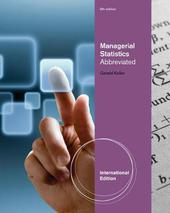
|
Managerial Statistics, Abbreviated International Edition (with Printed Access Card)
Mixed media product
Main Details
| Title |
Managerial Statistics, Abbreviated International Edition (with Printed Access Card)
|
| Authors and Contributors |
By (author) Gerald Keller
|
| Physical Properties |
| Format:Mixed media product | | Pages:816 | | Dimensions(mm): Height 255,Width 204 |
|
| Category/Genre | Business mathematics and systems
Probability and statistics |
|---|
| ISBN/Barcode |
9781111534288
|
| Classifications | Dewey:519.5024658 |
|---|
| Audience | | Tertiary Education (US: College) | |
|---|
| Edition |
International Edition
|
|
Publishing Details |
| Publisher |
Cengage Learning, Inc
|
| Imprint |
South-Western College Publishing
|
| Publication Date |
2 May 2011 |
| Publication Country |
United States
|
Description
This worldwide best-selling business statistics book teaches readers how to apply statistics to real-world business problems through the author's unique three-step approach to problem solving. Readers learn to IDENTIFY the right technique by focusing on the problem objective and data type. They then learn to COMPUTE the statistics by hand or by using Excel (R) or Minitab. Finally, they INTERPRET the results in the context of the problem. This approach enhances user comprehension as well as practical skills.
Author Biography
Dr. Gerald Keller is Emeritus Professor of Business at Wilfrid Laurier University, where he taught statistics, management science, and operations management from 1974 to 2011. He also taught at the University of Toronto, the University of Miami, McMaster University, the University of Windsor, and the Beijing Institute of Science and Technology. In addition to consulting with banks on credit scoring and credit card fraud, Dr. Keller has conducted market surveys for the Canadian government on energy conservation. His books include BSTAT, 2e, APPLIED STATISTICS WITH MICROSOFT EXCEL, ESSENTIALS OF BUSINESS STATISTICS (co-authored), AUSTRALIAN BUSINESS STATISTICS (co-authored), and STATISTICS LABORATORY MANUAL EXPERIMENTS USING MINITAB. Dr. Keller also has been published in OMEGA, IIE TRANSACTIONS, DECISION SCIENCES, INFOR, ECONOMICS LETTERS, and ARCHIVES OF SURGERY.
Reviews1. What Is Statistics? Key Statistical Concepts. Statistical Applications in Business. Statistics and the Computer. World Wide Web and Learning Center. Appendix 1: Instructions for the CD-ROM. 2. Graphical Descriptive Techniques I. Types of Data and Information. Describing a Set of Nominal Data. Describing the Relationship between Two Nominal Variables and Comparing Two or More Nominal Data Sets. 3. Graphical Descriptive Techniques II. Graphical Techniques to Describe a Set of Interval Data. Describing Time-Series Data. Describing the Relationship between Two Interval Variables. Art and Science of Graphical Presentations. 4. Numerical Descriptive Techniques. Measures of Central Location. Measures of Variability. Measures of Relative Standing and Box Plots. Measures of Linear Relationship. APPLICATIONS IN PROFESSIONAL SPORTS: Baseball. APPLICATIONS IN FINANCE: Market Model. Comparing Graphical and Numerical Techniques. General Guidelines for Exploring Data. Appendix 4: Review of Chapters 2 to 4. 5. Data Collection and Sampling. Methods of Collecting Data. Sampling. Sampling Plans. Sampling and Nonsampling Errors. 6. Probability. Assigning Probability to Events. Joint, Marginal, and Conditional Probability. Probability Rules and Trees. Bayes' Law. Identifying the Correct Method. 7. Random Variables and Discrete Probability Distributions. Random Variables and Probability Distributions. Bivariate Distributions. APPLICATIONS IN FINANCE: Investment Portfolio Diversification and Asset Allocation. Binomial Distribution. Poisson Distribution. 8. Continuous Probability Distributions. Probability Density Functions. Normal Distribution. Exponential Distribution. Other Continuous Distributions. 9. Sampling Distributions. Sampling Distribution of the Mean. Sampling Distribution of a Proportion. Sampling Distribution of the Difference between Two Means. From Here to Inference. 10. Introduction to Estimation. Concepts of Estimation. Estimating the Population Mean When the Population Standard Deviation Is Known. Selecting the Sample Size. 11. Introduction to Hypothesis Testing. Concepts of Hypothesis Testing. Testing the Population Mean When the Population Standard Deviation Is Known. Calculating the Probability of a Type II Error. The Road Ahead. 12. Inference about One Population. Inference about a Population Mean When the Standard Deviation is Unknown. Inference about a Population Variance. Inference about a Population Proportion. APPLICATIONS IN MARKETING: Market Segmentation. 13. Inference about Two Populations. Inference about the Difference between Two Means: Independent Samples. Observational and Experimental Data. Inference about the Difference between Two Means: Matched Pairs Experiment. Inference about the Ratio of Two Variances. Inference about the Difference between Two Population Proportions. Appendix 13: Review of Chapters 12 and 13. 14. Analysis of Variance. One-Way Analysis of Variance. Multiple Comparisons. Analysis of Variance Experimental Designs. Randomized Blocks (Two Way) Analysis of Variance. Two-Factor Analysis of Variance. APPLICATIONS IN OPERATIONS MANAGEMENT: Finding and Reducing Variation. Appendix 14: Review of Chapters 12 to 14. 15. Chi-Squared Tests. Chi-Squared Goodness-of-Fit Test. Chi-Squared Test of a Contingency Table. Summary of Tests on Nominal Data. Chi-Squared Test for Normality. Appendix 15: Review of Chapters 12 to 15. 16. Simple Linear Regression. Model. Estimating the Coefficients. Error Variable: Required Conditions. Assessing the Model. Using the Regression Equation. Regression Diagnostics - I. Appendix 16: Review of Chapters 12 to 16. 17. Multiple Regression. Model and Required Conditions. Estimating the Coefficients and Assessing the Model. Regression Diagnostics - II. Regression Diagnostics- III (Time Series). Appendix 17 Review of Chapters 12 to 17. Appendix A: Data File Sample Statistics. Appendix B: Tables. 1. Binomial Probabilities. 2. Poisson Probabilities. 3. Normal Probabilities. 4. Critical Values of t. 5. Critical Values of x2. 6. Critical Values of F. 7. Critical Values of the Studentized Range. 8. Critical Values for the Durbin-Watson Statistic. Appendix C: Answers to Selected Even-Numbered Exercises.
|